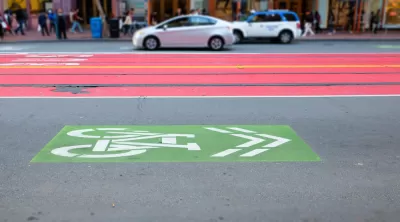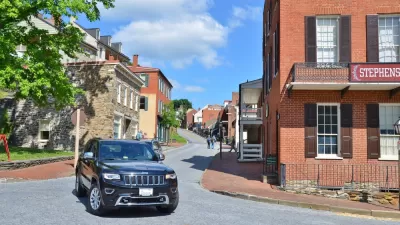Education, engineering, and enforcement are the three "e's" of Vision Zero in San Francisco. A lack of on of those "e's"—enforcement—might explain why more people are dying on the city's streets this year that any year since the city adopted Vision Z

San Francisco is five years into a ten-year Vision Zero goal, according to an article by Heather Knight, but traffic fatalities are rising on the city's streets. So far in 2019, "22 people have lost their lives on the city’s streets. That’s one less than died in all of 2018 and two more than died in all of 2017." That total includes 15 pedestrians. Another five people have died on freeways located in the city.
"[The city is] on pace to surpass the 31 deaths in 2014, the year Vision Zero began," adds Knight.
Looking for answers to the question of why San Francisco is backsliding on traffic safety, Knight identifies a lack of traffic enforcement as a likely culprit.
"New figures obtained by The Chronicle show the San Francisco Police Department is ticketing far fewer drivers for illegal behavior behind the wheel than it did the year Vision Zero was adopted," according to Knight. The neglect of traffic enforcement "could be explained by too many unfilled vacancies in the department’s traffic division and ever-changing leadership of the crucial unit."
The article includes more information about the lack of traffic safety enforcement, including data specific to the kinds of tickets written and in which neighborhoods.
FULL STORY: Deaths on SF’s streets are up. Traffic enforcement is down. ‘It’s hard to believe these aren’t related’

Manufactured Crisis: Losing the Nation’s Largest Source of Unsubsidized Affordable Housing
Manufactured housing communities have long been an affordable housing option for millions of people living in the U.S., but that affordability is disappearing rapidly. How did we get here?

Americans May Be Stuck — But Why?
Americans are moving a lot less than they once did, and that is a problem. While Yoni Applebaum, in his highly-publicized article Stuck, gets the reasons badly wrong, it's still important to ask: why are we moving so much less than before?

Using Old Oil and Gas Wells for Green Energy Storage
Penn State researchers have found that repurposing abandoned oil and gas wells for geothermal-assisted compressed-air energy storage can boost efficiency, reduce environmental risks, and support clean energy and job transitions.

Updating LA’s Tree Rules Could Bring More Shade to Underserved Neighborhoods
A new USC study finds that relaxing Los Angeles’ outdated tree planting guidelines could significantly expand urban tree canopy and reduce shade disparities in lower-income neighborhoods, though infrastructure investments are also needed.

California's Canal Solar Projects Aim to Conserve Resources and Expand Clean Energy
California’s Project Nexus has begun generating electricity from solar panels installed over irrigation canals, with researchers and state agencies exploring statewide expansion to conserve water and boost clean energy production.

HHS Staff Cuts Gut Energy Assistance Program
The full staff of a federal program that distributes heating and cooling assistance for low-income families was laid off, jeopardizing the program’s operations.
Urban Design for Planners 1: Software Tools
This six-course series explores essential urban design concepts using open source software and equips planners with the tools they need to participate fully in the urban design process.
Planning for Universal Design
Learn the tools for implementing Universal Design in planning regulations.
Heyer Gruel & Associates PA
City of Moreno Valley
Institute for Housing and Urban Development Studies (IHS)
City of Grandview
Harvard GSD Executive Education
Salt Lake City
NYU Wagner Graduate School of Public Service
City of Cambridge, Maryland





























